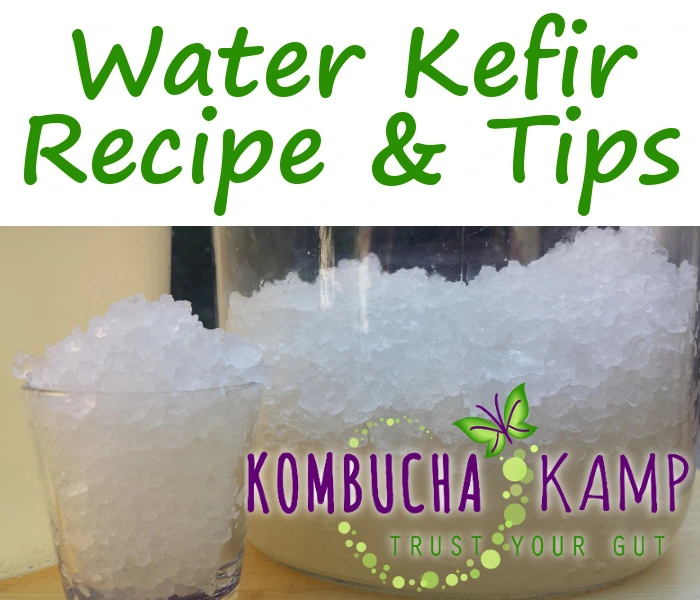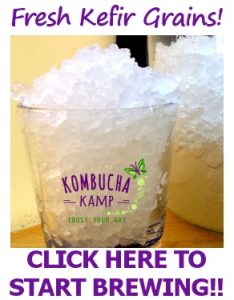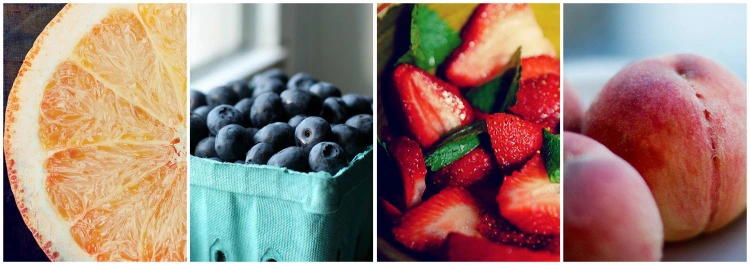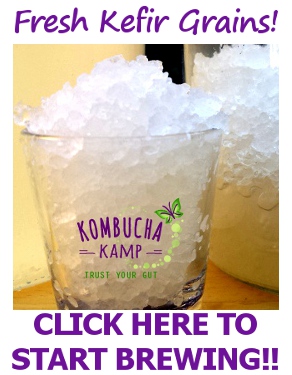Easy Water Kefir Recipe For Brewing Success!
As bacteriosapiens with over 500 organisms living inside of and on our bodies, we need a variety of ferments to keep our digestive and immune system health and strong. Many might find Kombucha a bit too tangy at first. New brewers may get impatient with the longer fermentation time. However, the typical Water Kefir recipe requires only 1-2 days from start to finish! This makes for a much lighter tasting brew. Plus it’s loaded with healthy bacteria and yeast which delivers a nutritional boost in living form. Passed down through the generations, this simple ferment can provide a delicious, probiotic alternative to the chemical laden sodas, energy drinks and pasteurized juices that populate store shelves. Water kefir is dairy free, grain free and vegan friendly. Check out our water kefir recipe below! (Water Kefir FAQ Here)

Sweet but somewhat bland without a second ferment, flavored water kefir is reminiscent in taste and effervescence of a natural soda pop. Similar to Kombucha and dairy kefir, water kefir “grains” (named for their appearance only) are a SCOBY that digests sugar to create beneficial probiotics. Unlike Kombucha, the water kefir recipe does not call for tea, so there is no caffeine. This also means there are not as many powerful enzymes and acids in water kefir. But water kefir does contain a higher number of beneficial bacteria.
The water kefir grain is a mixture of bacteria and yeasts in a polysaccharide biofilm that act in symbiosis, creating a culture that is stable. Where the grains originated for certain, like all of the fermented food starter cultures, is difficult to pinpoint.
What are Water Kefir Grains?
 Water kefir is a name of convenience. Due to the similarity of the appearance of the “grains”, these two distinct fermented beverages now share a common name. The traditional names for water kefir grains perhaps explain a bit more about their origins and usage. Since a rose would still smell as sweet, we also assume that kefir water has much of the same benefit that lead to its cultivation and sharing since ancient times. Or has it changed over time?
Water kefir is a name of convenience. Due to the similarity of the appearance of the “grains”, these two distinct fermented beverages now share a common name. The traditional names for water kefir grains perhaps explain a bit more about their origins and usage. Since a rose would still smell as sweet, we also assume that kefir water has much of the same benefit that lead to its cultivation and sharing since ancient times. Or has it changed over time?
The kefir grain is not actually a grain but rather, a symbiotic polysaccharide containing both yeast and bacteria that ferment sucrose into a lightly sweet and bubbly brew that repopulates the gut with healthy organisms to balance the digestive and immune system.
Plus, it is super easy to flavor in a myriad of ways providing infinite variety. They can also be utilized with other substrates to create unique beverages with additional benefits. These include fruit juices and coconut water. Want to ferment nut milks? Milk kefir grains work best for that.
Why Brew Water Kefir vs Kombucha?
- Its easy & fast! The typical water kefir recipe calls for 24-48 hours fermentation time. Kombucha takes 7-14 days per brewing cycle.
- Small batches are good! Due to the shorter fermentation time, making smaller amounts works best – perfect for one person. Kombucha is best made in 1 gallon size batches or larger.
- Its diverse! Water Kefir may have 400+ types of organisms that repopulate the gut and boost immunity.
- Its not too sour! Some people find Kombucha too tangy to enjoy. Water Kefir has a lighter profile that many fermentation newbies enjoy.
- Its free! Dairy-free, caffeine-free, and vegan friendly. Plus it reproduces rapidly so you can share with friends or feed extra grains to the chickens.
![]() A Grain by any other name…
A Grain by any other name…
Water kefir has a bunch of neat, old names. Here are just a few.
Tibicos, tibi, sugar kefir grains, Japanese water crystals, California bees,
Tibetan Sea Bees, bébées, African bees, ale nuts, Australian bees,
balm of Gilead, beer seeds, beer plant, bees, ginger bees,
Japanese beer seeds and vinegar bees
What other names for Water Kefir have you heard? Drop us an email! ~ Hannah
Easy Water Kefir Recipe and Instructions
*Click Here for a Coconut Water Kefir Recipe
The ingredients for water kefir are likely lurking in your kitchen cupboards. Water, sugar, WKG and time is all you need to make this tasty brew. The following water kefir recipe is for a ratio of 2 tablespoons of grains per 4 cups of water. Scale up or down as needed.



 (59 votes, average: 3.78 out of 5)
(59 votes, average: 3.78 out of 5)![]() Loading…
Loading…
– Yield: about 1 Quart
– Calories per 8oz Serving: about 20
– Prep Time: 5 minutes
– Cook Time: 36 hours
– Total Time: 36 hours 5 minutes
Ingredients
- 2 Tablespoons hydrated Water Kefir Grains
- ¼ cup sugar – organic preferred*
- 1 quart of chlorine free water *
*Using a sugar with higher mineral content, such as rapadura, piloncillo or turbinado will help the grains reproduce. You can also use molasses but avoid raw honey.
*If using purified water through a filtration system, then you may also add one of the optional additions to remineralize it. To dechlorinate water, allow to sit for 24 hours or boil for 10 minutes then cool to needed temp.
Optional Additions
Equipment
- Half Gallon Glass Jar or One Gallon Glass Jar
- Mesh strainer or cheesecloth
- Cloth with rubber band, Fermentation Cap, or plastic lid
- Spoon, measuring cup and funnel
- Bottles or jars for finished kefir
Directions
- Add ¼ cup of sugar to the jar.
- Add water to the jar.
- Stir thoroughly to dissolve the sugar.
- Add 2 TB of kefir grains to the sweetened water.
- Cover with a plastic lid, cloth cover or Fermentation Cap.
- Let sit for 24-48 hours – no longer than 72 hours or the grains will begin to disintegrate.
The water kefir recipe will produce a slightly fizzy beverage with a pleasantly sweet taste. Once it has the flavor you prefer best, then strain the kefir through a strainer or cheesecloth to recapture the grains. If you prefer a tangier brew, do a second ferment of the water kefir in the bottle to yield a deeper flavor. After you remove the grains, add flavors for a second fermentation or drink straight. Develop your own favorite water kefir recipe based on experimentation. Repeat & enjoy!
Click Here to Order Fresh Water Kefir Grains from Kombucha Kamp Today & Start Brewing!
Water Kefir Troubleshooting Tips
- Grains do not need to be rinsed between uses. If rinsing is desired, do so in filtered water.
- Grains do not always reproduce every batch but may be used again and again.
- If left longer than 72 hours, grains are at risk for starvation and may disappear.
- The correct temperature range for fermenting water kefir is 68-78°F (20-26°C) with the ideal temperature being 75°F (24°C). Warmer temps result in faster fermentation whereas cooler temps will slow it down.
- If you notice the kefir is ready before 24 hours, add more sugar solution to the next batch, shorten the fermentation cycle or reduce the amount of grains to 2 Tablespoons per quart.
- If grains fail to reproduce, they may need additional nutrition – add one of the optional additions listed in the water kefir recipe above.
- Grains can get slimy or change shape if too many minerals are used. If you notice this, use white sugar or remove any additions to prevent them from dissolving.
Water Kefir Health Benefits
Like all fermented drinks or foods, water kefir has a vast array of benefits. It is full of beneficial bacteria, yeasts, enzymes, easily digested sugars, acids, vitamins and minerals. One study showed that Water Kefir contained over 450 kinds of beneficial bacteria! Water kefir sends billions of health-bestowing bacteria and yeast into your gut, helping your body with digestion, absorption of vitamins and minerals, and helping your immune system fight off unwanted bacteria, yeasts and viruses.
Though it is fermented from sugar, the enzymes in water kefir kefir grains break down sucrose into more easily digested fructose and glucose. Processed by the liver, fructose does not spike blood sugar in the same ways as sucrose. The amount of sugar remaining at the end of a water kefir ferment will depend on the ingredients used and the length of culturing time. In general, the longer you ferment a beverage with sugar, the less will remain in the final ferment. Due to the presence of yeast, water kefir also has a small percentage of alcohol though typical under .08% but up to as much as 3% depending on fermentation time and technique used.
Water Kefir Recipe Flavoring Suggestions
Just like Kombucha and other fermented drinks, flavoring the basic Water Kefir recipe to invent new great taste combinations is at least half the fun of making it at home! Give these water kefir recipe flavor ideas a try – let us know which ones are your favorite!
* All recipes are intended to flavor 16oz of Water Kefir – adjust quantities accordingly

Fruity Water Kefir Recipe Flavors
- Strawberry Mint
- 2 whole strawberries, diced
- 2 mint leaves, chiffonade
- Blueberry Thyme
- Peach Spice
- 1/4 peach (AMZ), diced, skin removed (optional)
- 1/4 tsp chai spice
- Grapefruit Refresher
- 1-2 TB fresh grapefruit juice
- 1-2 slices ginger root
“Soda” Water Kefir Recipe Flavors
- Rootbeer – check out the Root Beer Flavoring Pack here!
- 1/8 tsp sassafras
- 1/8 tsp sarsaparilla
- 1/4 tsp wintergreen
- 1/8 of whole vanilla bean
- Orange Pop
- 1/4 cup fresh squeezed OJ
- 1/2 tsp fresh squeezed lemon juice
- Ginger Ale
- Lemon Lime Soda
- 1/4 lemon, juiced
- 1/4 lime juiced (AMZ)
- 1/8 tsp lemon zest
- 1/8 tsp lime zest
*Scroll down for KKamp’s Coconut Water Kefir Recipe!
Long Term Storage & Renutrification of Water Kefir Grains
Living Water Kefir grains are more sensitive to adverse elements and are not prone to keeping as well as Kombucha SCOBYs do in a hotel. If you need to take a break from making Water Kefir, here is what to do.
Long Term Storage
1-7 days: Place the grains in a glass and cover with water. Store in the refrigerator.
7-14 days: Place the grains in a glass. Leave them dry (no liquid) with 1/8 tsp molasses. Store in the refrigerator.
14+ days: Lay kefir grains out on a cookie sheet or dehydrator sheet. Dehydrate at 98-105F until dry. Store dehydrated grains in freezer safe bag in the freezer or in a dry, cool location out of direct sunlight.
The longer the grains starve or sleep, the longer it may take to revive them. The revived grains will also not have the same bacteria diversity but it will regain diversity as they are woken up and used again. As such, they may need to be renutrified prior to fermenting the first batch. If you notice slow fermentation or if you have been using them with another substrate, follow these steps to reactivate the grains and make them more lively.
Renutrify Kefir Grains Recipe:
- Place the grains into a dish.
- Add just enough water so the grains are completely covered.
- Sprinkle 1 Tablespoon of sugar into the water and add a raisin or two.
- Cover with a cloth and set in a warm spot 75-85°F (24-30°C).
- Check on them after 12 hours to see if you observe any signs of fermentation – this will be manifested in the appearance of small bubbles around the edges and a change in turbidity. If you see bobbing raisins, that is a good sign. You may now use the grains to brew your first half batch of 2 cups and 1/8 cup of sugar – keeping the vessel in a warm location will speed up the fermentation process. Continue checking every 12 hours for up to 3 days.
- Once that is successful, then scale recipe based on qty of grains.
**If no fermentation is observed, add a 1/4 cup of water and 1/2 teaspoon of molasses and gently stir. Check again in 12-24 hours. If no signs of fermentation such as those listed above are exhibited after a week or so, fresh grains may be required.
Water Kefir Quick FAQ
What is water kefir?
Water Kefir is a probioitic beverage made from sugar and water. It has numerous organisms that repopulate the gut to improve digestion and boost immunity.
How much kefir I should be drinking each day?
Trust YOUR gut! Humans evolved consuming fermented drinks on a daily basis. Listen to how your body responds. If you experience any adverse symptoms, you may be experiencing a Herxheimer reaction. Otherwise, drink as much as you crave!
What is the difference between water kefir grains and powdered kefir starter culture?
Living or hydrated water kefir grains maintain a greater diversity of living organisms than dehydrated versions. This is due to the large number of organisms that thrive in the living substrate. While many of them may be retained through the dehydration process, it can take several batches before they attain the same level of diversity. Hydrated grains are quick to propagate and reproduce quickly so that you will have extras to share!
Does water kefir have the same benefits as milk kefir?
Water Kefir & Milk Kefir are two completely different colonies of organisms. Water Kefir is best for those seeking increased numbers of organisms in their gut and its a vegan, dairy-free option. Milk Kefir has the benefit of fermenting milk which has protein, different vitamin and mineral content as well as different types of organisms specifically adapted to consume lactose. However, it is neither vegan nor dairy free. Both cultures can be used to ferment other types of substrates with different nutritional components such as nut milks, coconut water and fruit juice.
Water kefir vs Milk kefir – which is better?
Water kefir and milk kefir are 2 distinct ferments. Each has its own host of beneficial bacteria, yeast and healthy properties. As to which is better for you, there are a couple of factors to consider.
- Dairy
- Milk kefir requires milk. If you are lactose intolerant, you may still enjoy milk kefir because the living bacteria in the kefir breaks down the lactose for you.
- Those who don’t consume dairy may prefer water kefir.
- Tangy flavor
- Milk kefir or any soured milk product will have a different type of tanginess. Water kefir is very mild in flavor and has a sweeter profile.
- If you don’t like tang, go for the water kefir.
- Ferment other substrates
- Milk kefir grains may be used to ferment cow’s milk, goat’s milk, or other nut milks including coconut milk.
- A water kefir recipe can be adapted to use ferment sugar water, juice or coconut water.
Are water kefir grains reusable?
Yes! They will also reproduce. Strain the grains prior to flavoring to recapture and start the next batch.
How long do water kefir grains (WKG) last?
WKG will last indefinitely if properly maintained. They require fresh nutrient solution in order to thrive. Grains may be reused several times and will also replicate leading to infinite abundance!
How long does it take to make water kefir?
Water Kefir is made in small batches due to the short fermentation time. In warmer temps it can be ready in 24 hours. Cooler climates may need 48-72 hours for a quart size batch to be ready. Your water kefir recipe will also vary based on your personal taste preference.
How will I know if I’ve successfully made water kefir? How do I know if I shouldn’t drink it?
Water Kefir has a pleasantly sweet taste but is not cloying. As a lactic acid ferment with a higher pH than Kombucha, it does not have the same type of acid profile. Many newbies to fermentation appreciate the lighter flavor. Those used to Kombucha may find it too sweet, but bottle aging will lead to a nice, dry flavor. Do not drink water kefir if it tastes like fermentation is not occurring (i.e. like straight sugar water) or if it has obvious signs of mold.
Do I have to use a lid or cloth cover with water kefir? What about an airlock?
We have fermented water kefir grains with a variety of lid configurations – plastic lid, cloth cover and airlock. We found that all of them delivered equally good results so use whichever configuration works best for you. Experiment to see if you prefer the flavor better when the grains have access to oxygen or without! Avoid metal lids as they may corrode over time, though if they have a plastic liner, they will be safe to use.
How long can I store the water kefir in the refrigerator?
Water Kefir Grains may be stored in the fridge for brief periods of time up to a month. Water kefir itself can be stored in the fridge or out of the fridge indefinitely, but the flavor will continue to change and may not be appealing after a few weeks.
Do I need to rinse the water kefir grains off between batches?
Contrary to some schools of thought, we DO NOT recommend rinsing Water Kefir grains between uses. In fact, some of the back slop (yes, that’s a technical term) may be used as “starter” especially when the weather is cooler or there are a fewer amount of grains. The same bacteria and yeast that comprise the grains are also present in the liquid.
How much sugar remains after fermentation?
According to a recent study in Belgium, all of the sucrose was converted after 24 hours. There will still be some fructose and glucose present which gives water kefir its sweeter flavor. Adjust your preferred water kefir recipe to ferment longer if you wish to reduce sugar even more.
What type of sugar should I use to make water kefir?
The best sugar is sucrose or table sugar. We prefer to use sugar that still retains some of the mineral content and isn’t as refined (evaporated cane juice crystals) but many different types of sugar may be used. Some sugars have a higher mineral content that may change the flavor – so experiment with extra grains in case a batch doesn’t turn out. Here’s a list of potential sugars to use with Water Kefir: sucanat (AMZ), rapadura, piloncillo, coconut palm (AMZ) and turbinado (AMZ)

